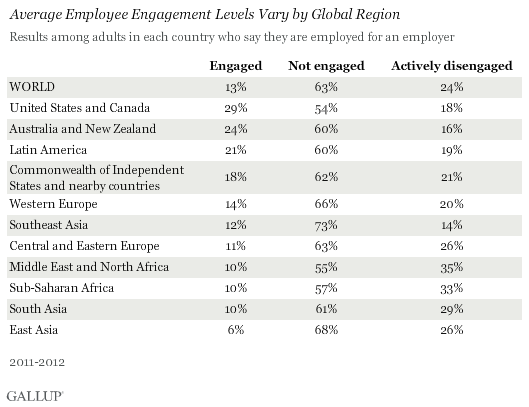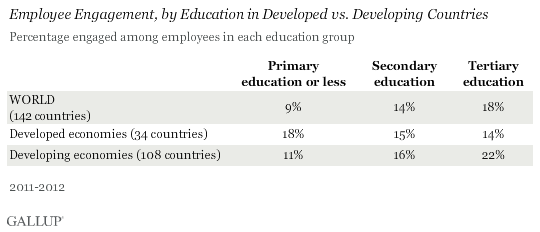WASHINGTON, D.C. -- Only one in eight workers worldwide are engaged at work, but according to Gallup's new 142-country study on the State of the Global Workplace, engagement varies considerably according to the region and country in which these workers live and their economic and social conditions.

The U.S. and Canada lead the world with 29% of employees engaged at work, followed by workers in Australia and New Zealand, at 24%. The proportion of engaged employees in Western Europe is 14%, about half that in Northern America, implying that workplace lethargy could impede economic dynamism in many European countries. On the other hand, 6% of workers in East Asia are engaged; this group consists primarily of Chinese workers who are among the least engaged in the world.
Regional Differences Highlight Need to Align Education Systems With Employers' Needs
The regional data show interesting relationships between employees' educational attainment and their likelihood to be engaged at work. In developing regions where higher education is less common -- such as sub-Saharan Africa, South Asia, and Southeast Asia -- engagement trends sharply upward with education. In such regions, university degrees are almost certain to lead to job types that make good use of graduates' relatively rare levels of expertise. For most developing countries, better access to higher education goes hand in hand with economic diversification and development.
In economically developed countries, however, employees' likelihood to be engaged declines slightly as their education levels rise. This finding raises the possibility that in countries where higher education levels are commonplace, better-educated employees may be less likely to hold jobs that they feel allow them to do what they do best. In the U.S., for example, studies show that about 50% of recent college graduates are unemployed or in jobs that don't require a college degree.

Gallup's data underline the importance of aligning education with labor market conditions to maximize employee engagement and productivity. For many students in the developed world, a four-year college degree may not be the best path to a job that makes the most of their inherent talents. Vocational and technical schools may need more focus as alternatives to four-year colleges, particularly in developed countries that are currently seeking to restore their manufacturing bases.
Implications
The common thread in all countries is that expanding the types of educational opportunities available will help more students obtain a greater sense of where their talents lie. Employee engagement hinges on people's capacity to seek -- and find -- jobs that allow them to do what they do best and on managers giving employees the latitude they need to use their strengths in their daily work lives.
For complete data sets or custom research from the more than 150 countries Gallup continually surveys, please contact us.
Survey Methods
For the current workplace study, employee engagement results were collected among 73,752 respondents, aged 18 and older, in 141 countries via the Gallup World Poll, and 151,335 U.S. respondents using the Gallup Daily tracking survey. Employee engagement questions were asked only of those respondents who indicated they were employed for an employer, either full time or part time. Country-level results are weighted by population size to arrive at regional and global aggregates. For results based on the total global sample, one can say with 95% confidence that the margin of sampling error is less than ± 1 percentage point. The margin of error reflects the influence of data weighting. In addition to sampling error, question wording and practical difficulties in conducting surveys can introduce error or bias into the findings of public opinion polls.
Gallup measures employee engagement based on workers' responses to its Q12 survey, which consists of 12 actionable workplace elements with proven links to performance outcomes. To identify these elements, Gallup spent years conducting thousands of interviews at every level of various organizations, in most industries, and in several countries. Since Gallup finalized the Q12 question wording in the late 1990s, the survey has been administered to more than 25 million employees in 189 different countries and 69 languages. For a listing of the Q12 survey items and more information on how they relate to business performance outcomes, see the full State of the Global Workplace report.
For more complete methodology and specific survey dates, please review Gallup's Country Data Set details.
